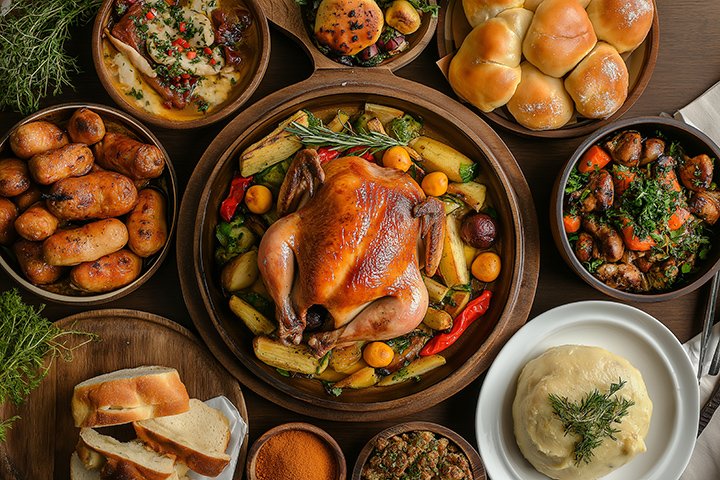Turkey Time: Essential tips to safely cook your Thanksgiving turkey
Despite being a day for giving thanks and gathering with loved ones, Thanksgiving is arguably best known for its festive feast. People spend all day in the kitchen, creating a plentiful arrangement of cranberry sauce, stuffing, mashed potatoes and gravy, green beans, and most importantly… turkey. While these foods are most memorable for their delectable tastes, it is equally important that these foods are made following correct food safety protocols. Specifically, turkey is known as a TCS, or time/temperature controlled for safety, food - meaning it is prime for pathogenic growth. There would be no worse way to end Turkey Day than everyone getting sick with a food-borne illness, so to avoid this fiasco, here are some Dos and Don’ts for keeping your turkeys safe.

DON’T – Thaw your turkeys on the counter
Thawing turkey, or any food, on the counter allows it to enter the temperature danger zone of 41°F to 135°F. If a turkey were to spend four or more hours within this temperature range, any pathogens present in the turkey would begin to grow. On the counter, the outside of the turkey would reach the temperature danger zone for more than four hours while its frozen center would continue to thaw, deeming it unsafe to eat.
DO – Use only safe thawing methods
There are several safe thawing methods, but the only one that logistically makes sense for a turkey is thawing with refrigeration. Turkeys may take several days to thaw in the refrigerator, which ensures the internal temperature of the turkey never goes above 41°F. However, this method does require some advanced planning.
DON’T – Rely on appearance to know when your turkey is done cooking
A whole turkey is a very thick piece of meat. With that being said, the outside of the bird will remain at a higher temperature than the inside/center throughout cooking. It is vital that the center of the turkey reaches the minimum internal temperature of 165F. Regardless of what the outside looks like, if the turkey has not reached that internal temperature, certain pathogens may still be present and alive.
DO – Measure internal temperature to know when your turkey is done cooking
The only way to definitively know when a turkey has reached an internal temperature of 165F is by using a calibrated thermometer suitable for thick food/meat. The thermometer stem should be inserted into two places - the thickest part of the breast and the thickest part of the thigh - and 15 seconds should be allowed before determining the final temperature reading. Both measurements must be at least 165F for the turkey to be considered done.
DON’T – Reuse equipment from prepping your turkey after it’s cooked
Any equipment used to prep the raw turkey may be contaminated with pathogens that could spread to the cooked turkey if that equipment is reused.
DO – Use clean and sanitized equipment for your cooked turkey
Using clean and sanitized equipment on cooked turkeys prevents cross-contamination. Be sure to use equipment not used for prepping the turkey, or equipment that has since been cleaned and sanitized.
DON’T – Leave your turkey sitting out while waiting to serve it
As a cooked turkey sits at room temperature, it is at risk of entering the temperature danger zone for pathogenic growth. The general rule of thumb is that food becomes unsafe after four hours in the temperature danger zone. The less time spent sitting out, the safer a turkey will be.
DO – Maintain the right turkey temp while waiting to serve
The best way to avoid temperature-abusing a cooked turkey is to time things so the turkey finishes cooking right before mealtime. However, if the turkey is done early, there are ways to protect it. Namely, keeping the turkey warm in the oven will keep it safe and above 135°F. More than that, it will keep the turkey perfectly warm for mealtime.
DON’T – Wait to store your leftovers in the fridge
When Thanksgiving dinner is over, the last thing people want to do is clean up. Even if the dishes are made to wait, put leftovers away as soon as possible. The longer a turkey sits on the counter, the longer it will spend in the temperature danger zone, increasing the risk for pathogenic growth.
DO – Cool your turkey to 41°F or lower as soon as possible
The name of the game for keeping turkey leftovers safe is getting the meat through the temperature danger zone as quickly as possible. One way to do this is to completely carve and slice the turkey before storing it as smaller pieces of meat will cool faster. Additionally, the turkey may be placed into the freezer or a blast chiller temporarily before it is transferred to the fridge. It is also important to note that leftovers should be consumed within 7 days of preparation.
Following this guide may not guarantee a holiday without family drama, but it can help ensure a day without drama related to food-borne illness.
Samantha Towers is a junior in the dietetics program at Central Michigan University. To learn more about the Nutrition and Dietetics program and course offerings, please contact program director Dr. Najat Yahia at yahia1n@cmich.edu.




